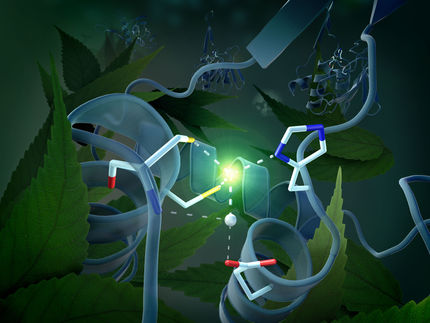Plant Defense as a Biotech Tool
Advertisement
Against voracious beetles or caterpillars plants protect themselves with cyanide. Certain enzymes release the toxic substance when the plant is chewed. These HNL-called enzymes are also important for industry. acib found a new biocatalyst in a fern which outshines all other HNL-type enzymes on the market.
Defense strategies are not only important in chess or military tactics but also in nature. Especially plants are masters in this discipline. Some stone fruit, almond trees or even ferns defend their young buds against feeding pests with cyanide. The poison expels the greatest enemy. This is due to an enzyme called hydroxynitrile lyase (HNL), which can release molecularly stored hydrogen cyanide.
What is useful for the plants, is also in demand in industry where the reverse reaction of the HNL-enzymes allows to bind cyanide to different molecules. This creates a double benefit. On the one hand, it is possible to recycle unwanted cyanide wastes, which for example are generated during the production of acrylonitrile. Acrylonitrile is not only used in adhesives, it is also the raw material for polyacrylonitrile or "acrylic", an important fiber for textiles. On the other hand, industry gains valuable building blocks for pharmaceutical agents or the vitamin synthesis. The extremely high specificity of the HNL-enzymes makes them so useful for industrial application. Ideally, through biocatalysis valuable products are derived from inexpensive precursors.
HNL-enzymes have a fine tradition in industry. The first HNL enzymes have been successfully developed in the mid-1990s at Graz University of Technology (TU Graz) and were used industrially for the production of insect repellents. Important improvements in the synthesis of high-value products aroused more industrial interest. The early enzymes certainly can’t meet all of today’s requirements, so researchers are searching for new HNL biocatalysts. Within the framework of the EU project KYROBIO, which deals with production technologies for new molecules, acib-researchers have successfully looked for those bio-tools.
Smell enzyme activity
The acib-researchers Margit Winkler, Elisa Lanfranchi and Anton Glieder finally made a find in the white rabbit's foot fern, where the scientists sniffed enzyme activity. "When you rub a young fern leave between the fingers, it smells of hydrocyanic acid and benzaldehyde (similar to marzipan), indicating that there is enzyme activity", explains Margit Winkler, "knowing that ferns show the desired activity, we have been searching in the woods and in commercially available plants". In three and a half years the acib-researchers in Graz have kept a close eye on eligible enzymes, examined their structure, produced the biocatalysts biotechnologically and tested their activity. Finally, the enzymes of a commercial rabbit’s-foot fern from the hardware store were the most promising. The Styrian bracken fern also showed activity and is currently being studied in more detail.
The new enzyme has an extremely high activity, although it is not even optimized. "Our new HNL is more efficient and simpler to handle than those previously used, because it is a small, uncomplicated enzyme", says Anton Glieder (TU Graz, acib). These results are a perfect basis for the industrial utilization. The range of applications is huge: It includes everything from crop protection to the production of repellents against mosquitoes and Co.
Original publication
Elisa Lanfranchi, Eva-Maria Köhler, Barbara Darnhofer, Kerstin Steiner, Ruth Birner-Gruenberger, Anton Glieder and Margit Winkler; "Bioprospecting for Hydroxynitrile Lyases by Blue Native PAGE Coupled HCN Detection"; Current Biotechnology; 4(2): 111-117.

























































